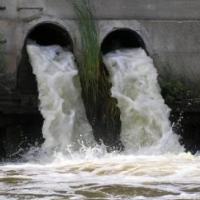Only Half of Chemical Contaminants in Great Lakes are Removed by Treatment Plants

Water treatment plants remove barely half of the prescription drugs and other “chemicals of emerging concern” (CECs) from sewage, according to a new report by the International Joint Commission (IJC), a U.S.-Canadian organization that regulates shared water uses and investigates transboundary issues and recommends solutions. Because treated effluent is discharged into the Great Lakes and other bodies of water, there is concern that some of the CECs will show up in drinking water as well.
Noting that the focus of environmental monitoring has recently “shifted to an array of recently discovered compounds known as ‘chemicals of emerging concern’,” the report states that CECs are “found in products used daily in households, businesses, agriculture and industry, such as flame retardants, pharmaceuticals, personal care products, and pesticides.”
To determine how well wastewater treatment plants on the Great Lakes are handling CECs, IJC conducted a study from 2009 to 2011 of their operations and of the effectiveness of various wastewater treatment technologies at removing 42 specific CECs.
The study found that six chemicals (an herbicide, an anti-seizure drug, two antibiotics, an antibacterial drug and an anti-inflammatory drug) were detected frequently and had a low rate of removal in treated effluent, while five more had a low rate of removal, but not frequent detection. The main finding was that “at least half of the 42 substances examined…are likely to be removed in municipal wastewater treatment plants.”
Although the authors readily admit that the health impact of having CECs in the water is unclear, they insist that more study is needed. “The compounds show up in low levels–parts per billion or parts per trillion–but aquatic life and humans aren’t exposed to just one at a time, but a whole mix,” Antonette Arvai, the lead author of the study, told Brian Bienkowski of Environmental Health News. “We need to find which of these chemicals might hurt us.”
More than 1,400 wastewater treatment plants in the U.S. and Canada discharge 4.8 billion gallons of treated water into the Great Lakes basin every day, and prior research has linked other drugs in fish to slower reaction times, altered eating habits and anxiety, according to the study.
Diana Aga, a chemistry professor at the University of Buffalo said consistently seeing antibiotics show up in effluent is cause of concern on its own. “Even at low levels you don’t want to have people ingest antibiotics regularly because it will promote resistance.”
-Matt Bewig
To Learn More:
Only Half of Drugs, Other Newly Emerging Contaminants Removed From Sewage (by Brian Bienkowski, Environmental Health News)
Protecting Our Great Lakes: Assessing the Effectiveness of Wastewater Treatments for the Removal of Chemicals of Emerging Concern (by Antonette Arvai, Gary Klecka, Saad Jasim, Henryk Melcer and Michael T. Laitta; International Joint Commission) (abstract)
14% of Mercury in Great Lakes Comes from China…but the Largest Source is Nearby Coal-Fired Power Plants (by Noel Brinkerhoff and David Wallechinsky, AllGov)
AK Steel Takes First and Third in Contest for Worst Polluter of U.S. Waterways (by Noel Brinkerhoff and David Wallechinsky, AllGov)
- Top Stories
- Unusual News
- Where is the Money Going?
- Controversies
- U.S. and the World
- Appointments and Resignations
- Latest News
- Trump to Stop Deportations If…
- Trump Denounces World Series
- What If China Invaded the United States?
- Donald Trump Has a Mental Health Problem and It Has a Name
- Trump Goes on Renaming Frenzy






Comments